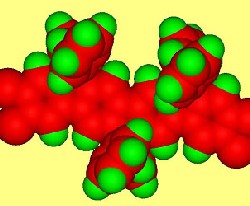A Little Impurity Goes a Long Way

A smattering of impurities might be the key to more efficient light-emitting diodes (LEDs) made from plastics. Researchers report that palladium atoms present at parts-per-million quantities in a polymer LED cause the material to phosphoresce. The effect, described in the 14 October print issue of PRL, could serve as a sensitive probe into the physics of polymers and lead to improved organic optoelectronic devices.
When a voltage is applied to a semiconductor diode, it can emit light. Researchers have begun to exploit conjugated polymers–repeating chains of organic molecules rich in double bonds between carbon atoms–in hopes of creating LEDs that can be molded like plastic and tuned easily from one color to another. One of the drawbacks to this approach is that much of the electrical energy of the applied voltage produces heat instead of light.
John Lupton of the Max Planck Institute for Polymer Research in Mainz, Germany, and his colleagues, didn’t set out to solve this problem. In routine testing of a new conjugated polymer for LEDs, the team saw a pink glow, rather than the blue-green they expected. Further experiments indicated that, in addition to the usual fluorescent light, the material was emitting phosphorescent light, which lasts for a longer time after the voltage is turned off. The phosphorescence was at a wavelength different from the fluorescence and caused the color change.
On closer inspection of the material, the group found that it did have one unusual feature: palladium atoms, left over from the catalyst used to synthesize the polymer, were present at 80 parts-per-million, or one for every 1700 units of the polymer. Chemists can’t even inject such low levels of a dopant with current techniques, Lupton notes. So-called metallorganic polymers also phosphoresce, he says, but each unit in those compounds contains a metal atom. The ubiquitous metal atoms strongly affect the electronic structure and drastically reduce the light-producing efficiency of metallorganics, whereas the new material is 99.9% metal-free.
The palladium atoms are nevertheless crucial. When a voltage is applied to a semiconductor, a positive charge forms at one terminal and a negative charge at the other. These combine to form a neutral “exciton,” which rapidly decays into a photon, if it has enough energy, or converts to heat, if it doesn’t. But if a metal atom such as palladium is around, it can convert some less energetic excitons into phosphorescence. The surprise here is that “so little of the heavy metal is needed to get a lot of this phosphorescence,” says Ifor Samuel of the University of St. Andrews in the UK.
The effect suggests that light emission can probe the properties of these lower-energy excitons, which researchers have rarely seen directly, as well as the chemistry of related materials. “It opens up a whole new toolbox,” says Lupton. He adds that metal impurities might also help polymer LEDs generate more light or improve the performance of organic dye lasers or single photon-emitters. Finally, the result raises a basic question about optimizing the levels of leftover catalyst and other impurities in materials, says Donal Bradley of Imperial College, London. “We should now ask, ‘At what point do such residues no longer matter?’”
–JR Minkel
JR Minkel is a freelance science writer in New York City.


